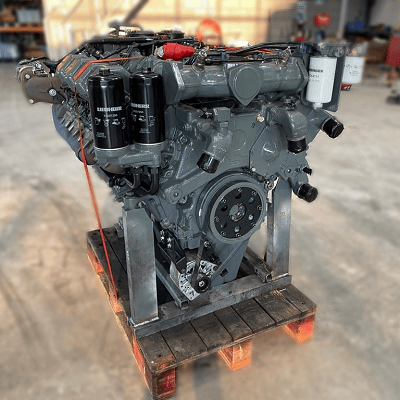The process of a dyno test on a Liebherr engine

When it comes to heavy machinery, reliability and power are paramount. Liebherr, a name synonymous with innovation and excellence in engineering, stands tall as a pioneer in the realm of heavy equipment and machinery. From towering cranes to robust excavators, Liebherr’s engineering prowess extends to the heart of these machines. We delve into the world of dyno testing a Liebherr engine, uncovering the meticulous process behind unleashing the raw power concealed within.
The foundation of excellence
Before we embark on the journey of dyno testing, it’s crucial to understand the foundation upon which Liebherr engines are built. With decades of engineering expertise and commitment to quality, Liebherr engines are crafted to withstand the most demanding environment and deliver unparalleled performance. Each component is meticulously designed and rigorously tested to ensure reliability, efficiency and longevity.
The process
1 Preparation: The engine undergoes meticulous preparation before being mounted onto the dynamo meter. This includes ensuring all connections are secure, fluids are filled to the appropriate levels, and sensors are properly calibrated.
2 Mounting: The engine is carefully mounted onto the dynamometer, a specialized device designed to simulate real-world operating conditions. Precision is paramount during this step to ensure accurate results.
3 Initial checks: Once mounted, a series of initial checks are conducted to verify proper alignment, connection integrity, and functionality of all engine systems.
4 Warm-up: The engine is started and allowed to warm up to operating temperature. This ensures consistent results and minimizes the risk of damage during testing.
5 Baseline testing: With the engine warmed up , baseline tests are conducted to establish initial performance metrics. This includes measuring power output, torque, fuel consumption, and emissions at various RPM levels.
6 Load testing: The engine is subjected to progressively increasing loads to simulate different operating conditions, such as idle, partial load and full load. This allows engineers to assess performance across the entire operating range and identify any potential issues or optimization.
7 Data analysis: Throughout the testing process, data is continuously collected and analyzed in real-time. Advanced instrumentation and software are used to monitor performance metrics and identify trends or anomalies.
8 Optimazation: Based on the data analysis, adjustments may be made to optimize engine performance. This could involve fine-tuning fuel injection timing, adjusting air-fuel ratios, or optimize turbocharger boost pressure.
9 Validation: Once testing is complete, the results are meticulously reviewed and validated against predetermined criteria and specifications. Any deviations or anomalies are thoroughly investigated to ensure accuracy and reliability.
10 Reporting: Finally, a comprehensive report is generated detailing the results of the dyno testing, including performance metrics, observations, and any recommendations for further optimization or refinement.
The outcome of dyno testing
Dyno testing a Liebherr engine is more than just a routine procedure – it’s a testament to the unwavering commitment to excellence that defines Liebherr’s engineering philosophy. By subjecting their engines to rigorous testing and analysis, Liebherr ensures that each engine delivers the uncompromising performance, reliability, and efficiency that customers expect.
In conclusion, dyno testing a Liebherr engine is not just about measuring power output. It’s about unlocking the true potential of these remarkable engines and ensuring they exceed expectations in the most challenging environments imaginable.
Cylinder assembly accessories include one front cover and one rear cover, one piston, two Y-type piston seals, one hard-wearing ring, one set of magnetic rings (some cylinders do not have magnetic rings), two cylinder seal O-rings, one piston rod sealing ring, one dustproof, two buffer caps, two buffer screws (with O-ring), one piston rod end thread, one piston fixing bolt, 8 fixing bolts, dustproof air inlet and outlet two caps, one piston rod end thread protection cover.Air Cylinder Tube.
Because the different application needs different strokes of air cylinders, for dealers and distributors, storing a large number of cylinders with fixed strokes will occupy a large amount of inventory funds.Pneumatic Cylinder Tube.
However, storing the Pneumatic Cylinder assembly parts can solve this problem very well. When requires different strokes and then temporarily assembling the cylinder accordingly.Air Cylinder Barrel.
Categories
Common cylinder assembly parts include DNC square cylinder series, ISO standard Metalwork series, SI Mickey Mouse type ISO 15552 cylinder series, SC and SU AirTac standard cylinder series, SDA compact cylinder series, and DSN, MA, MAL mini air cylinder series, etc. .
Matters needing attention when assembling the cylinder
For non-professional cylinder manufacturers, we do not recommend self-assembly to avoid problems caused by incorrectly assembling cylinders.
The following points need to be paid attention to when assembling an air cylinder by yourself:
â—† The inner edge of a pneumatic cylinder needs to be chamfered to facilitate the entry of the piston and sealing ring into the cylinder tube.
â—† Before assembling the piston and cylinder, lubricating grease must be applied to the inner wall of the cylinder to reduce the friction between the sealing ring and the inner wall of the air cylinder.Pneumatic Cylinder Barrel.
â—† The edge of the piston rod end also needs to be chamfered to reduce damage to dust and buffer seals.Pneumatic Cylinder.
â—† Because the end of the piston rod has external threads, special attention should be paid when assembling the piston rod and the front end cover. It is necessary to use the end of the piston rod without threads to pass through the gasket. Otherwise, the inner wall of the gasket is easily cut by the threads and resulting in an air leakage.
â—† For the installation of the tie rod cylinder, it is also necessary to pay attention to the position of the tie rod thread, so that there is enough thread space in the fixing bolts of the front and rear end covers to install the cylinder accessories such as CA, CB mounting brackets, FA/FB flange brackets.Cylinder Tube.
Pneumatic Cylinder Kits,Air Cylinder Kits,Pneumatic Air Cylinder Kits,Aluminum Cylinder Kits
Foshan Weiyingjia Technology Co., Ltd , https://www.wyspneumatic.com